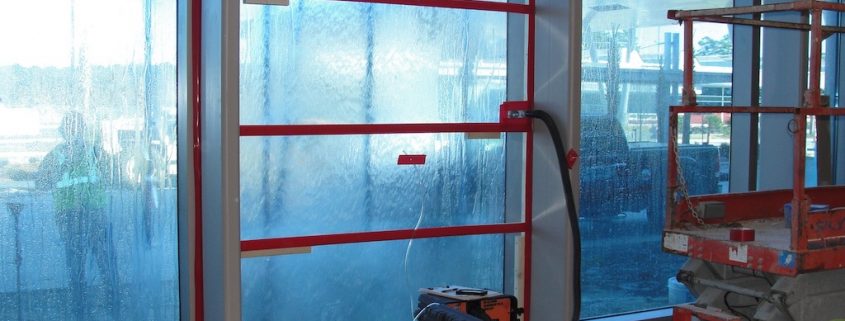
The AAMA 503 (Voluntary Specification for Field Testing of Newly Installed Storefronts, Curtain Walls, and Sloped Glazing Systems) is a field-testing guide developed by the American Architectural Manufacturers Association (AAMA). The AAMA 503 is primarily written for commercial applications as opposed to the AAMA 502, which is geared toward residential/multi-family applications.
The AAMA 503 guide provides specific details for testing procedures to ensure air and moisture penetration is minimized in newly installed fenestration systems.

The AAMA 503 guide provides useful verbiage that can be directly inserted into project specifications, saving time and effort. Unfortunately, it’s often inserted in a generic format that lacks specific details as to the areas, quantity, and specific testing pressures. Typically, a 1/3 reduction of the test pressure for field testing is specified as a reasonable adjustment for the differences between laboratory test environments and field-testing. It is up to the contractor to ensure these testing parameters are established.
The AAMA 503 is based on guidelines establish by ASTM International, formally known as the American Society for Testing and Materials. The ASTM E 1105 (Standard Test Method for Field Determination of Water Penetration of Installed Exterior Windows, Skylights, Doors, and Curtain Walls) is used for water penetration testing, and the ASTM E 783 (Standard Test Method for Field Measurement of Air Leakage Through Installed Exterior Windows and Doors) is used for air infiltration testing.
Additionally, the AAMA 503 specifies that the water penetration resistance testing shall be performed by using the Procedure A method of the ASTM E 1105, which is a consistent uniform static pressure for 15 minutes. It should also be noted that the AAMA 503 states that the air infiltration testing is OPTIONAL.
Testing: The AAMA 503 specifies that testing shall be performed as SOON as PRACTICAL after the glazing system is installed and PRIOR to the installation of drywall/interior finishes. If interior finishes have been installed, they MUST be removed at the area of the test chamber to allow visual access to verify testing performance.
The test specimen should be completely installed, adjusted, cleaned, and the perimeter sealed prior to testing. This includes adequate time for the perimeter sealant to be fully cured per the sealant manufacturer’s guidelines.
The architect or project specifier shall select the test specimen’s sizes and locations. It is not recommended to notify anyone of the actual test locations until the testing agency arrives onsite. If the installers know of the test locations, they will give these areas “special attention,” and testing results will not reflect accurate conditions. Typically, a sampling of areas from the project are selected and tested. The number of tests depends on the size and budget of the project.
With a large project, testing early on can prevent expensive repairs if a design flaw is identified during the first phase of testing. In case of leaks, the installer, waterproofing contractor, or the manufacturer will have an opportunity to make repairs to the test specimen, after which it will need to be re-tested.
Normally, if a test specimen fails, the contractor should be prepared for additional testing.
Air and water leakage (in that order) are determined using a test chamber of constant pressure. A predetermined amount of air leakage is allowable. Water leakage is defined as the presence of uncontrolled water that is not contained in an area with provisions to drain to the exterior or the collection of more than ½ oz. of water on the top of an interior horizontal framing member surface. Any water present shall not extend beyond the plane parallel to the glazing intersecting the innermost projection of the test specimen.
All failures will be subject to further forensic investigation.
The AAMA 503 guide establishes the requirements for testing specimens, testing apparatus, and sampling procedures prior to the issuance of the building occupancy permit (CO). If the building is occupied, and the installation is more than six months old, the AAMA 511 method shall be used. The AAMA 511 method will also be used where water penetrates the building envelope during testing; the ASTM E 2128 is an approved alternative method.
BDG utilizes professional testing equipment that is calibrated to each specific testing standard for accurate results. Our field consultants are properly trained and knowledgeable of all testing standards. BDG has extensive knowledge of most building systems and specializes in forensic water intrusion investigations. This allows us to not only properly test fenestrations on new construction projects, but also pinpoint the cause of any test failures and provide accurate recommendations to achieve successful testing results. Failures during quality assurance (new construction) testing can result in unnecessary delays that impact your bottom line.
If you are looking for a reputable second or third-party testing company to perform accurate professional testing, provide concise reports, and help you through the entire process, contact BDG today. We provide testing services throughout the United States from our headquarters located in Atlanta, GA.
Contact BDG today to discuss your next storefront / curtain wall water penetration testing project.

